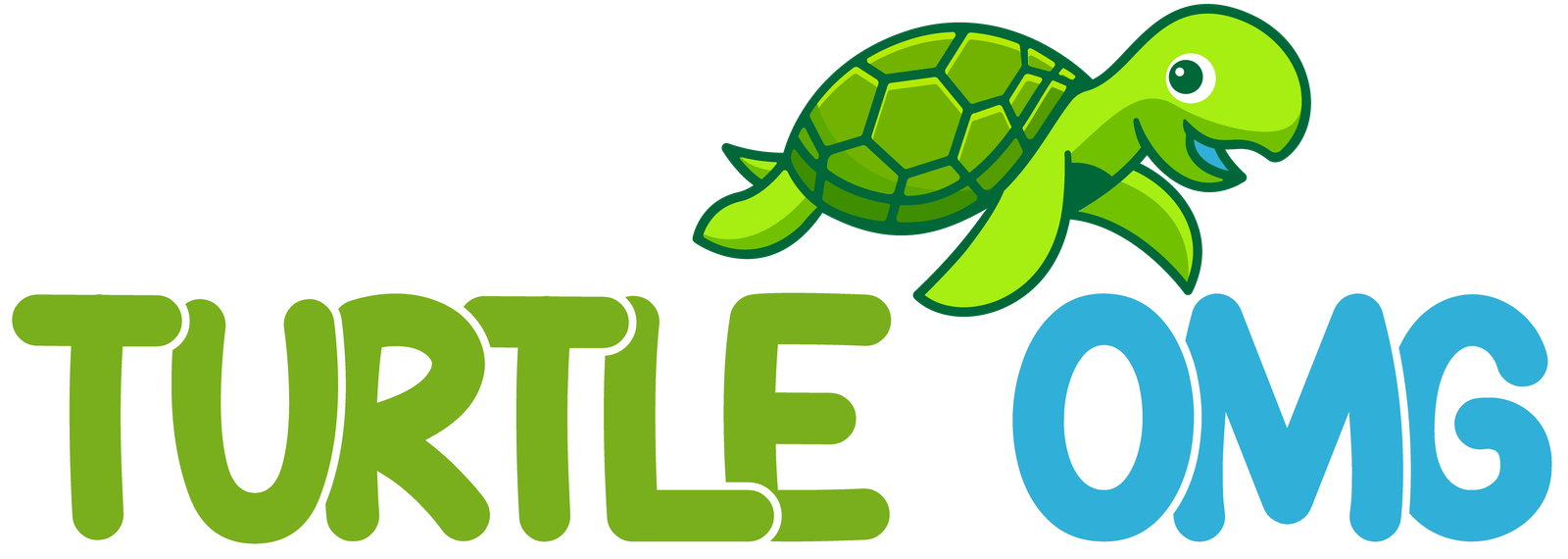The painted turtle is a semi-aquatic species, and it is known for its colorful shell and painted stripe design on its neck. As turtles are becoming a popular pet day by day, this turtle species is taking place among many owners’ rooms. Let’s say, as a new pet owner, you took a painted turtle. After that, the most basic question in your mind will be – “what do painted turtles eat”?
As a responsible pet owner, you have to understand painted turtles’ basic dietary needs to keep them healthy. They are omnivores, and they savor both plant and animal matter. In the wild, painted turtles mainly eat insects and aquatic plants. However, in captivity, you have to make sure to maintain a balanced diet; otherwise, your health condition can go bad. So, this post will discuss the specifics of – what painted turtles eat in captivity or in the wild to ensure that you can plan the right diet for them.
What Do Painted Turtles Eat In the Wild?
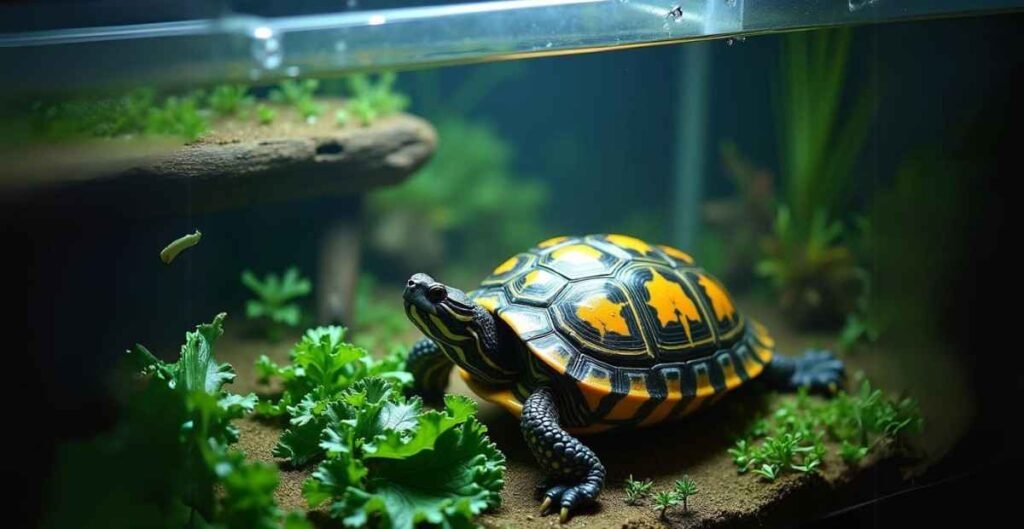
Painted turtles are mainly omnivores when they are adult. This means that they consume both plant and animal matter. Baby painted turtles follow more on a carnivore feeding habits. They are known as bottom-dwelling hunters. They thrive in the wild on diverse food sources, including plants, invertebrates, and other meat-based food sources.
A study released in the Herpetological Review in 2000 shows fascinating insights into the eating habits of the Midland Painted Turtle. Researchers found insects in the stomachs of 35 out of 48 turtles that were examined.
Now, let’s see in the wild what painted turtles eat from their surroundings.
Invertebrates and Aquatic Plants
These turtles primarily feed on invertebrates, foraging along the bottoms of lakes and ponds. They enjoy consuming aquatic plants such as algae and water lilies, which are abundant in nutrients. In their natural environment, these colorful plants play an essential role, especially in species such as the Chrysemys picta picta. This species loves to eat colorful plant-based food.
Insects and Small Fish
Painted turtles hunt for insects and small fish, which provide vital proteins and nutrients. The eastern painted turtle is recognized for eating injured or dead fish/invertebrates. Meanwhile, the Western variety changes its diet with the changes in the seasons. During the early summer months, western painted turtle species eat 60% of insects in their diet. As summer comes to a close, their diet shifts to include more plants, which make up roughly 55% of what they consume.
Seasonal Variations and Coloration
Painted turtles’ diets shift with the seasons, which is influenced by the availability of food sources. During the spring and summer months, the lush growth of plants results in a higher rate of plant consumption. Carotenoid plant food is good for painted turtles’ health, and this type of food improves their immune system.
What Can Painted Turtle Eat in Captivity (Dietary Needs)?
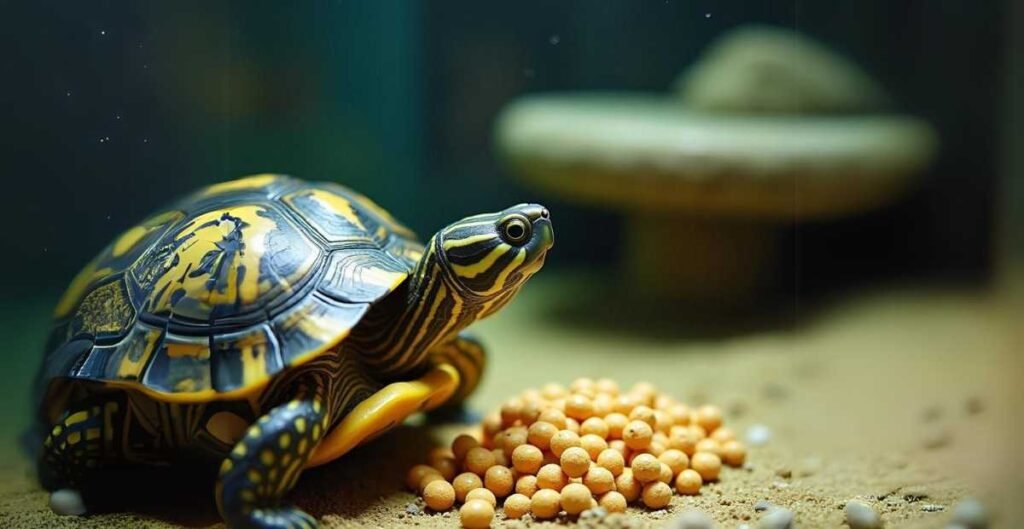
If you are a responsible painted turtle owner, knowing about their right dietary need is a must. You have to make sure they receive a balanced mix of nutrients similar to what they would find in the wild. Here’s a comprehensive guide to meeting their dietary needs.
Importance of Balanced Diet
Painted turtles are omnivores, thriving on a mix of animal and plant matter. In captivity, it’s crucial to mimic this natural diet to promote their health and longevity. A varied diet helps maintain their energy, supports growth, and strengthens their immune system.
What can you feed painted turtles in captivity? A detailed list is provided below-
Insects and Protein Sources:
You should incorporate a range of insects like crickets, mealworms, and midge larvae into your pet-painted turtle diet. These offer vital proteins and resemble the types of food turtles would seek out in their natural habitat. From time to time, provide small fish, such as guppies and minnows, as they serve as great sources of protein. Here is a list –
- Crickets
- Mealworms
- Midge larva
- Guppies
- Minnows
- Snails
- Dragonfly larvae
- Tadpoles
- Small frogs
- Earthworms
Aquatic Plants and Vegetables:
You can provide a variety of aquatic plants, such as duckweed, water lettuce, and anchors. Vegetables like kale, dandelion greens, and red-leaf lettuce make excellent additions. These offer essential vitamins and minerals. You can serve the following –
- Duckweed
- Water lettuce
- Anacharis
- Kale
- Dandelion greens
- Red-leaf lettuce
- Cattail shoots
- Water lilies
- Algae
- Rigid hornwort
Fruits as Treats:
Occasionally provide small, seedless fruit pieces such as melon and berries. Fruits should be provided in moderation to prevent excessive sugar consumption. You can consider the following fruits –
- Melon (small, seedless pieces)
- Berries (without seeds)
- Shredded apple (without seeds)
- Banana slices (occasionally)
- Strawberries
Commercial Pellets:
High-quality pellets are another essential option for maintaining painted turtles’ right nutritional balance. They are formulated to meet turtles’ nutritional needs and can be used as a staple. If you want to consider pellets, the following options are the best –
Consider brands like Omega One, Tetra ReptoMin, and Mazuri, which are known for their nutritional content. If you want to know which turtle pellet can be your best option, you can check here.
What do Eastern Painted Turtles Eat?
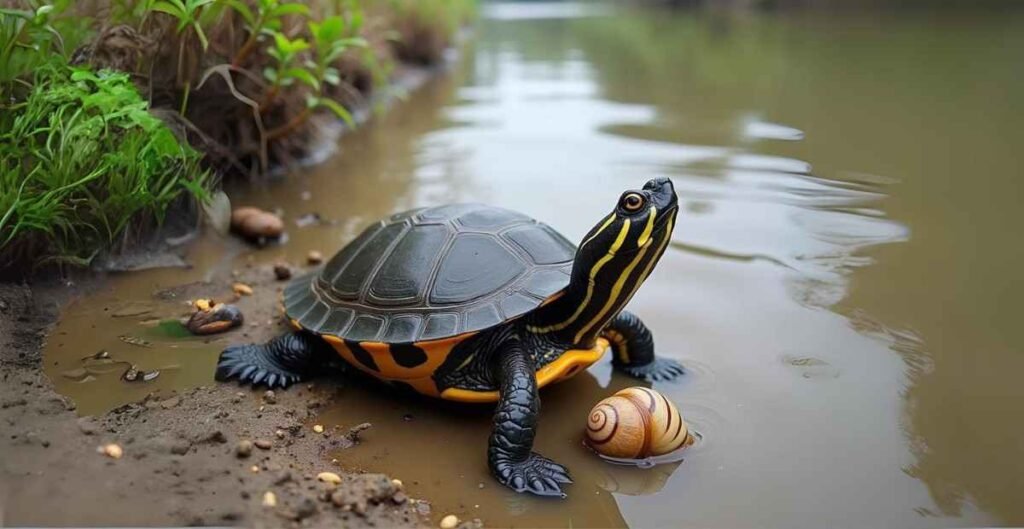
Among all of the painted turtle species, Eastern Painted Turtles are the most common and are found in North America, from Nova Scotia to Alabama. They are known for their vibrant black shells with red markings.
So, if you have one of these eastern-painted turtles as a pet, it’s best to know about their specific dietary requirements. However, all of these sub-species have a common food habit.
Dietary Preferences
Eastern Painted Turtles have a clear preference for injured or dead fish, which they can easily catch and eat. In addition to fish, they frequently consume insects such as dragonfly larvae and beetles, which are plentiful in their environments.
Differences in Food Sources by Region
The diet of Eastern Painted Turtles can differ greatly based on where they are found. In areas rich with vibrant aquatic plants, they may eat a wider variety of vegetation, such as duckweed, water lettuce, and water hyacinth.
On the other hand, in areas with a larger population of aquatic animals, eastern painted turtles may eat snails and crayfish in addition to small invertebrates.
In colder regions, these turtles have developed the ability to endure harsh winters by entering a brumation state. During this time, their metabolic rate significantly drops, which enables them to survive without food for long stretches of time. During the warmer months, they maximize their reserves as food is more available.
What is The Feeding Schedule for Painted Turtles?
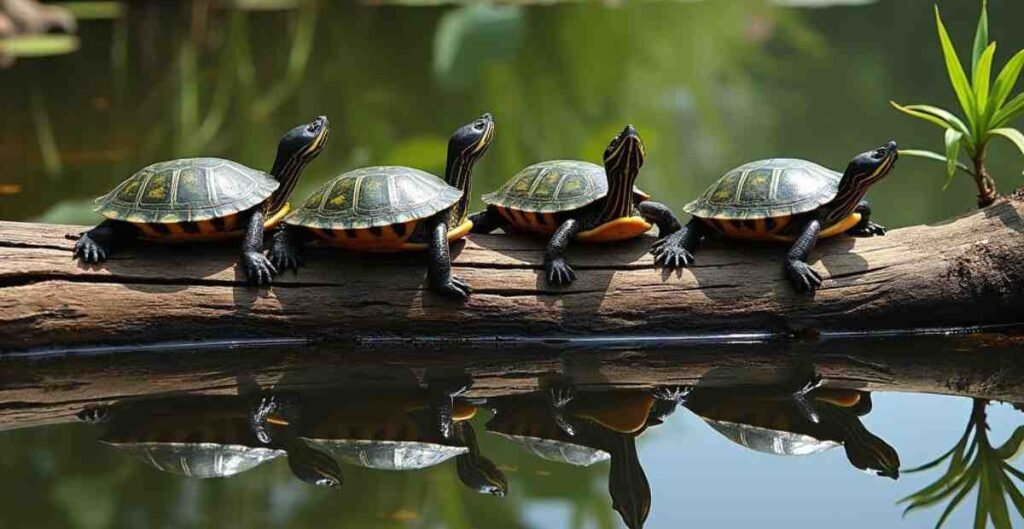
To maintain the right diet, knowing your painted pet turtle’s food schedule is vital.
Hatchlings and Juveniles
Hatchlings and young painted turtles need to be fed every day because they have a fast metabolism and grow quickly. Feeding them in the morning is ideal since that’s when they are at their most active. A diet abundant in protein is essential for their growth and development. Provide a combination of commercial pellets, live insects such as crickets and mealworms, along with small fish.
You can utilize the head size method to measure portion sizes. It means you can provide them with a quantity of food that can comfortably fit within the size of their head. This approach prevents overfeeding and guarantees nutrients.
Adults
As painted turtles grow older, their metabolism decreases, and they need to be fed less often—approximately 2-3 times each week. They should incorporate more plant-based foods into their diet, including leafy greens and aquatic plants, along with occasional sources of protein.
Keep utilizing the head size method for portion control to ensure a balanced diet and avoid overfeeding.
Recommendations for Serving Sizes
Getting the portion sizes right is essential for maintaining the health of your painted turtle. The head method is straightforward and efficient for measuring the right portion.
Common Mistakes to Avoid When Feeding Painted Turtles
Caring for painted turtles involves recognizing and avoiding dietary errors. Here are a few key points to keep in mind.
Overfeeding and Its Consequences
Overfeeding is a common error that can lead to obesity in painted turtles. An overweight turtle may struggle to move and could experience a shorter lifespan. Additionally, overfeeding can cause shell deformities, including pyramiding, leading to a shell with a raised and uneven surface. To prevent these issues, use the head size method when measuring portions. This ensures that your turtle gets the right amount of food without any excess.
Avoiding Inappropriate Foods
Not all types of food are safe for painted turtles. Keep them away from processed human foods, which often contain preservatives and additives that can harm them. If served regularly, phosphorus-rich foods, like spinach and beet greens, can mess with painted turtles’ calcium absorption, which is key for shell health. You should feed them aquatic plants, insects, and turtle pellets made especially for them.
Importance of Calcium and Vitamin D
Calcium and vitamin D play an essential role in keeping a healthy shell. Insufficient levels of these nutrients can result in soft shell syndrome, causing the shell to become weak and susceptible to harm. Make sure your turtle receives sufficient calcium by using supplements or cuttlebone, and ensure it has access to UVB lighting. UVB light helps painted turtles produce vitamin D, a crucial component for calcium absorption.
Wrap Up
While discussing this question, “What do painted turtles eat?” the answer is they can have both plant and meat-based food. In the wild, they can manage their own and get the nutrition they need from their surrounding. However, in captivity, providing the right diet for painted turtles is essential for their health and well-being. Adjust the feeding strategy according to their age, providing daily meals for hatchlings and offering food to adults a few times each week. Consistently monitor their well-being and adjust their nutrition as necessary to ensure they continue to flourish.
FAQs
What vegetables do turtles eat?
Turtles enjoy a variety of vegetables. You can try serving leafy greens like lettuce and kale. You can also offer them carrots and squash. Avoid vegetables high in phosphorus, like spinach, as they can interfere with calcium absorption.
What to Feed Pet Turtles?
You can feed pet turtles a mix of commercial pellets, fresh vegetables, and proteins like crickets or mealworms. Ensure their diet is balanced, and add calcium supplements if necessary to support their shell health.
Can painted turtles eat fruit?
Yes, painted turtles can eat fruit, but in moderation. Fruits like apples, berries, and melons are good choices. Remember, fruits should be a treat and not a major part of their diet, as they are high in sugar.
How often should I feed my painted turtle?
Feeding frequency depends on their age. Hatchlings and juveniles need to eat daily due to their fast metabolism. Adults can eat 2-3 times a week. Always use the size of the head method to determine portions.
What do pet turtles eat in general?
Pet turtles can have varied diets. They eat commercial turtle pellets, leafy greens, and protein sources like insects and small fish. A balanced diet is key to keeping them healthy.
